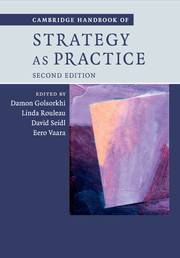Book contents
- Frontmatter
- Contents
- List of figures
- List of tables
- List of boxes
- List of contributors
- Preface to the Second Edition
- Introduction: what is strategy as practice?
- Part I Ontological and Epistemological Questions
- Part II Theoretical Resources: Social Theory
- Part III Theoretical Resources: Organization and Management Theories
- Part IV Methodological Resources
- 24 Using ethnography in strategy-as-practice research
- 25 Researching strategists and their identity in practice: building ‘close-with’ relationships
- 26 Studying strategizing through biographical methods: narratives of practices and life trajectories of practitioners
- 27 Researching everyday practice: the ethnomethodological contribution
- 28 Critical discourse analysis as methodology in strategy-as-practice research
- 29 Studying strategy as practice through historical methods
- 30 Quantitative methods in strategy-as-practice research
- Part V Substantive Topic Areas
- Index
- References
29 - Studying strategy as practice through historical methods
from Part IV - Methodological Resources
Published online by Cambridge University Press: 05 October 2015
- Frontmatter
- Contents
- List of figures
- List of tables
- List of boxes
- List of contributors
- Preface to the Second Edition
- Introduction: what is strategy as practice?
- Part I Ontological and Epistemological Questions
- Part II Theoretical Resources: Social Theory
- Part III Theoretical Resources: Organization and Management Theories
- Part IV Methodological Resources
- 24 Using ethnography in strategy-as-practice research
- 25 Researching strategists and their identity in practice: building ‘close-with’ relationships
- 26 Studying strategizing through biographical methods: narratives of practices and life trajectories of practitioners
- 27 Researching everyday practice: the ethnomethodological contribution
- 28 Critical discourse analysis as methodology in strategy-as-practice research
- 29 Studying strategy as practice through historical methods
- 30 Quantitative methods in strategy-as-practice research
- Part V Substantive Topic Areas
- Index
- References
Summary
Introduction
This chapter is about why and how historical methods are suitable for studies of strategy as practice with its focus on activities that characterize strategy and strategizing, for which the umbrella term ‘strategy-making’ is often used (Vaara and Whittington 2012). The ambition is to bring clarity to how we can approach strategy-as-practice research from a historical perspective. By introducing and elaborating different categories of historical methods, the chapter offers specific insights into how to use such methods.
Strategy-as-practice research contributes by providing important insights into practice, praxis, and the role and identity of practitioners, using a variety of methods (Jarzabkowski and Spee 2009: Vaara and Whittington 2012). Although some studies do incorporate the notion of history, the interest in historical method is limited. Kaplan and Orlikowski's (2013) study of a dynamic set of strategy-making practices reveals, through the development of chronologies, that managers negotiate and resolve differences in interpretations of the past, present and future. The influence of history on present strategic activity is also apparent in studies of sociocultural codes (Rouleau 2005), the sedimentation of social praxis into practices of replicating routines (Campbell-Hunt 2007) and with regard to an organization's predisposition to act path-dependently (Jarzabkowski 2004). Drawing on Bourdieu (1990), scholars direct attention to practice in relation to habitus – that is, the agent's predisposition to act in a certain way in a field, which denotes a social world, such as an industry or a market. History is mentioned in connection with habitus and field. The construction of habitus and field implies long-lasting processes, conditioned by environment, experience and history (Gomez 2010; Gomez and Bouty 2011). Without explicitly referring to history or a historical method, Whittington, Cailluet and Yakis-Douglas (2011) provide a long view of strategy professionals, in-house strategic planners and external strategy consultants. The long view is based on an analysis of advertisements for these professionals in The New York Times between 1960 and 2000. It should also be acknowledged that studies implicitly account for history through a focus on the emergent character of strategy practice (for example, Balogun and Johnson 2004; Dougherty 2004; Giraudeau 2008; Hendry, Kiel and Nicholson 2010; Jørgensen and Messner 2010; Stensaker and Falkenberg 2007). With a concern for language and discourse, SAP scholars further indicate that history does play a role (Clarke, Kwon and Wodak 2012). Through a narrative act, the researcher captures a sociohistorical dimension (Rouleau 2010).
- Type
- Chapter
- Information
- Cambridge Handbook of Strategy as Practice , pp. 506 - 519Publisher: Cambridge University PressPrint publication year: 2015
References
- 8
- Cited by



